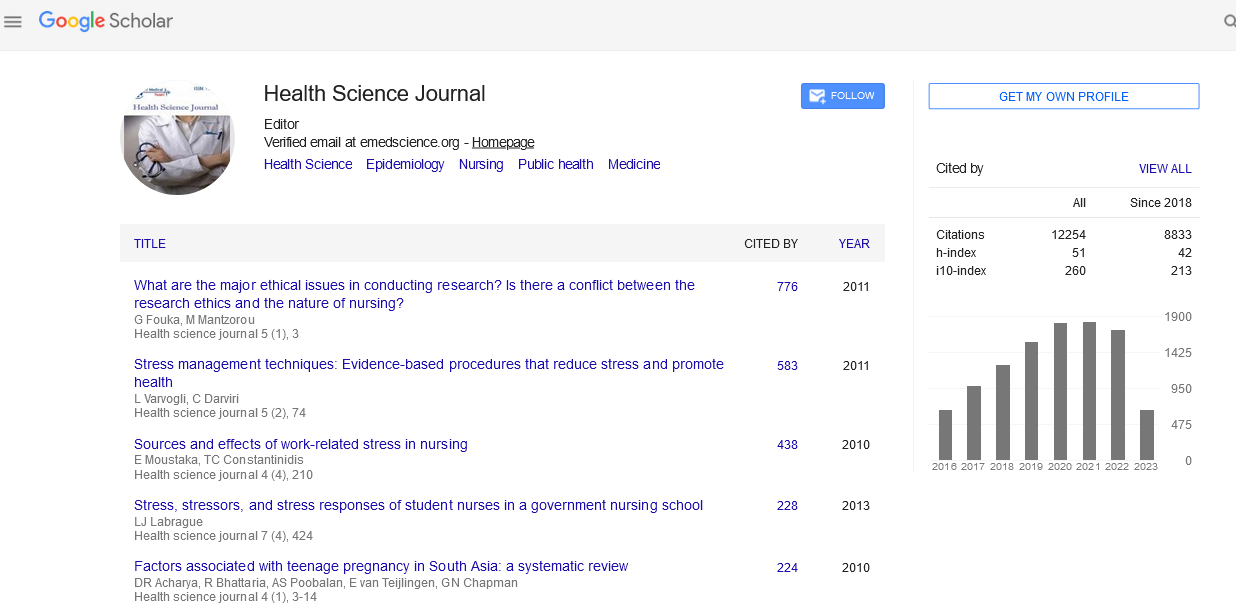Editorial - (2024) Volume 18, Issue 12
Health Implications of 'Loneliness' in Rural Populations
Zhiyuan Bo
Department of Mental Health, Karolinska Institutet, Sweden
Received: 01-Dec-2024, Manuscript No. Iphsj-24-15447;
Editor assigned: 04-Dec-2024, Pre QC No. Iphsj-24-15447 (PQ);
Reviewed: 26-Dec-2024, QC No. Iphsj-24-15447;
Revised: 28-Dec-2024, Manuscript No. Iphsj-24-15447 (R);
Published:
31-Dec-2024, DOI: 10.36648/1791-809X.18.12.1208
Abstract
Loneliness is increasingly recognized as a significant public health concern, particularly in rural populations. Rural communities often face unique challenges that contribute to social isolation, such as geographic remoteness, limited access to healthcare, and fewer social services. This article explores the health implications of loneliness in rural populations, examining its effects on both physical and mental health. It also discusses the social determinants of health, including access to social support, healthcare, and community engagement, and how these factors can either exacerbate or alleviate the health impacts of loneliness. The article concludes by highlighting the need for targeted interventions to mitigate the negative health consequences of loneliness in rural areas, with an emphasis on improving social connectivity, healthcare access, and community infrastructure.
Introduction
Loneliness has emerged as a significant concern for public health globally, with profound implications for both mental and physical well-being [1]. While loneliness is often considered a universal experience, it is particularly prevalent in rural populations. The dynamics of rural living—characterized by geographic isolation, fewer social services, and limited access to healthcare—can exacerbate feelings of loneliness, leading to serious health consequences. The impact of loneliness is further compounded by the demographic structure of many rural areas, where aging populations are more common and younger individuals often migrate to urban centers for better economic opportunities [2]. Social isolation in rural populations is often linked to various factors, including the lack of social engagement, inadequate transportation, and limited access to community resources. Loneliness, while subjective, has tangible effects on health outcomes, including increased risks of chronic diseases, mental health disorders [3], and premature mortality. Understanding the health implications of loneliness in rural populations is critical for developing effective interventions and policies that can improve the overall well-being of these communities. This article examines the link between loneliness and health, focusing on the physical, mental, and social factors that contribute to and are affected by loneliness in rural areas.
Physical Health Implications
The physical health consequences of loneliness are profound and multifaceted. Loneliness has been shown to increase the risk of chronic health conditions, such as heart disease, hypertension, diabetes, and obesity. Studies have found that individuals who report higher levels of loneliness are more likely to experience elevated blood pressure, poorer immune function [4], and higher levels of inflammation. This is likely due to the stress response that loneliness triggers in the body, which can lead to chronic conditions over time. Loneliness can also lead to unhealthy behaviors, such as poor diet, lack of physical activity, and substance abuse. In rural areas, where access to healthcare services and wellness programs is often limited, individuals may not have the resources or social support necessary to adopt healthier lifestyles. For instance, older adults in rural communities, who are at a heightened risk for loneliness, may struggle with mobility issues and lack the motivation or assistance to engage in regular physical activity. Additionally, social isolation can reduce the likelihood of individuals seeking medical attention [5], potentially delaying the diagnosis and treatment of physical health conditions. Furthermore, loneliness in rural populations can increase the likelihood of hospitalizations and higher healthcare costs. Individuals who experience chronic loneliness may experience diminished overall health, leading to more frequent doctor visits, hospital stays, and long-term care. For individuals in rural areas, the burden of accessing healthcare services—often a significant distance away—can exacerbate these challenges and increase the risk of severe health outcomes [6].
Mental Health Implications
The mental health consequences of loneliness are just as significant as the physical health risks, with loneliness serving as a primary risk factor for depression, anxiety, and cognitive decline. In rural populations, where mental health services are frequently sparse or unavailable, individuals who experience loneliness are less likely to receive adequate psychological support [7]. Loneliness is particularly linked to depression and anxiety, with studies showing that socially isolated individuals are more likely to experience symptoms of these disorders. The lack of social interaction and support systems in rural areas can exacerbate feelings of sadness, hopelessness, and anxiety. For older adults, loneliness can be a significant contributor to cognitive decline and dementia. The lack of mental stimulation and social engagement, which are often more easily accessible in urban environments, increases the risk of memory loss and cognitive impairment in rural populations. In addition to depression and anxiety, loneliness can increase the likelihood of suicidal ideation, particularly among elderly individuals in rural areas who may already be struggling with physical health problems, mobility limitations, or the loss of close family members. The isolation experienced by rural dwellers can create a sense of helplessness and despair, further elevating the risk of mental health crises.
Social Determinants of Health and Loneliness
Social determinants of health play a critical role in the experience and impact of loneliness in rural populations. These determinants—such as access to healthcare, social support, education, and economic resources—can either mitigate or exacerbate feelings of isolation. One of the key social determinants in rural areas is access to social support. In rural communities, social networks are often smaller, and the opportunities for individuals to engage in community activities or build social connections are limited. This lack of social engagement is compounded by physical distance and transportation barriers, making it difficult for individuals to maintain relationships or seek out new social opportunities. Another important social determinant is access to healthcare services. In many rural areas, healthcare facilities are fewer and more spread out, requiring individuals to travel long distances to receive care. This can be especially challenging for elderly individuals, those with chronic illnesses, or individuals without reliable transportation. The lack of easily accessible healthcare can contribute to the worsening of both physical and mental health conditions, reinforcing the cycle of loneliness. Economic factors also play a role in the experience of loneliness in rural areas. Economic decline in rural communities can lead to job loss, poverty, and the out-migration of younger individuals, leaving behind an older, more isolated population. Financial instability can further limit access to transportation, healthcare, and social services, all of which contribute to the feelings of isolation and loneliness.
Interventions and Solutions
Given the profound impact of loneliness on health in rural populations, targeted interventions are necessary to reduce its prevalence and mitigate its effects. One of the most effective strategies is increasing access to social support networks. Rural communities can benefit from initiatives that promote social engagement, such as local community centers, senior programs, and volunteer opportunities. Encouraging social interaction through regular community events can help build a sense of belonging and reduce isolation. In addition, expanding access to healthcare services—particularly mental health services—is crucial. Telemedicine, which has gained traction in rural areas, can help bridge the gap in healthcare access, allowing individuals to consult healthcare professionals without traveling long distances. Rural health programs can also integrate mental health care into primary care settings, reducing the stigma associated with seeking psychological help. Improving transportation options is another key intervention, as reliable transportation can help rural residents access healthcare, attend social events, and participate in community life. Programs that provide transportation assistance for older adults or individuals with disabilities can make a significant difference in reducing isolation.
Conclusion
Loneliness in rural populations is a serious public health issue with wide-ranging implications for both physical and mental health. The geographic isolation, limited social services, and fewer community resources that characterize rural living can exacerbate feelings of loneliness, leading to increased risks of chronic diseases, mental health disorders, and premature mortality. Addressing the health implications of loneliness in rural populations requires a multi-faceted approach that targets social determinants of health such as social support, healthcare access, and transportation. By fostering community engagement, expanding healthcare resources, and addressing the unique challenges of rural living, it is possible to mitigate the negative health effects of loneliness and improve the well-being of rural populations. Public health initiatives and policies should prioritize the mental and physical health needs of these communities, ensuring that rural residents have the support and resources they need to thrive.
References
- E Von Mutius (2010) 99th Dahlem conference on infection, inflammation and chronic inflammatory disorders: viruses, autoimmunity and immune regulation. Clin Exp Immunol 160: 113-119.
Google Scholar, Crossref
- Blyth CC, Robertson PW (2006) Anti-streptococcal antibodies in the diagnosis of acute and post-streptococcal disease: streptokinase versus streptolysin O and deoxyribonucleic B.Pathology 38: 152-162.
Indexed at, Google Scholar, Crossref
- Alok YA (2020) Membranous Nephropathy
Google Scholar
- Fogo AB, Lusco MA, Najafian B, Alpers CE (2015) Atlas of Renal Pathology: Membranous Nephropathy. Am J Kidney Dis 66: 15-17.
Indexed at, Google Scholar, Crossref
- Stanescu HC, Arcos-Burgos M, Medlar A, Bockenhauer D, Kottgen A, et al. (2011) Risk HLA-DQA1 and PLA(2)R1 alleles in idiopathic membranous nephropathy. N Engl J Med 364:616-626.
Indexed at, Google Scholar, Crossref
- Fresquet M, Rhoden SJ, Jowitt TA, McKenzie EA, Roberts I, et al. (2020) Auto antigens PLA2R and THSD7A in membranous nephropathy share a common epitope motif in the N-terminal domain. J Auto immun 106: 102308.
Indexed at, Google Scholar, Crossref
- Wang D, Yang L, Zhang P, LaBaer J, Hermjakob H, et al. (2017) AAgAtlas 1.0: a human auto antigen database. Nucleic Acids Res 45:D769-d76.
Indexed at, Google Scholar, Crossref
Citation: Bo Z (2024) Health Implications of 'Loneliness' in Rural Populations. Health Sci J. Vol. 18 No. 12: 1208.





